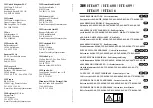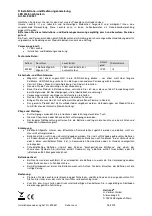
TRIPOD SYSTEM
USER INSTRUCTIONS
Page 3
ENGLISH
USE INSTRUCTIONS AND LIMITATIONS
I
MPORTANT
Before use, the user must read and understand these User Instructions. Keep
these User Instructions for reference.
P
URPOSE
The Tripod System is designed to be used as part of a personal fall arrest,
rescue, work positioning, or material handling system.
U
SE
I
NSTRUCTIONS
1.
Failure to follow all instructions and limitations on the use of the Tripod
System may result in serious personal injury or death.
2.
Before using a personal fall arrest system, employees must be trained in
accordance with the requirements of OSHA 29 CFR 1910.30 in the safe use
of the system and its components.
3.
Personal fall arrest systems, including the Tripod System, must be inspected
prior to each use for wear, damage, and other deterioration. Defective
components must be immediately removed from service, in accordance with
the requirements of OSHA 29 CFR 1910.140 and 1926.502.
4.
The complete fall protection system must be planned (including all
components, calculating fall clearance, and swing fall) before using.
5.
Users must have a rescue plan, and the means to implement it, that provides
for the prompt rescue of employees in the event of a fall, or assures that
employees are able to rescue themselves.
6.
Store the Tripod System in a cool, dry, clean environment and out of direct
sunlight when not in use.
7.
After a fall occurs on the system, immediately remove from service until a
“competent person” can make the determination for reuse or disposal.
U
SE
L
IMITATIONS
1.
CAPACITY: The Tripod System is designed for a single user only, and is
designed for two users at one time only for emergency rescue applications,
with a capacity (including clothing, tools, etc.) up to 310 pounds (140 kg)
total working weight per user, in conjunction with compatible connecting
components.
2.
EXTENDED SUSPENSION: The Tripod System is designed for use in
extended suspension applications.
3.
CORROSION: Do not leave the Tripod System in environments where
corrosion of metal parts could take place as a result of vapors from organic
materials. Use near seawater or other corrosive environments may require
more frequent inspections to ensure corrosion damage is not affecting the
performance of the product.


































